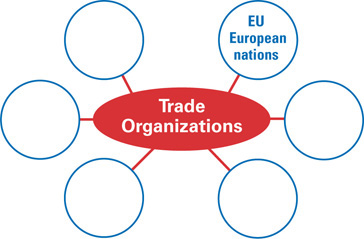Chapter 17 Assessment
Chapter Summary
A summary of major ideas in Chapter 17 appears below. See also the Guide to the Essentials of Economics, which provides additional review and test practice of key concepts in Chapter 17.
-
Section 1 Why Nations Trade (pp. 441–447)
Because resources are distributed unevenly throughout the world, nations specialize in producing certain goods and services, then trade to acquire the goods and services that they cannot produce. Nations, like individuals, specialize in producing goods and services based on the law of comparative advantage: that is, nations should specialize in producing the goods for which they have the lowest opportunity cost. As a result of specialization, both sides in the trading relationship benefit from trade.
-
Section 2 Trade Barriers and Agreements (pp. 449–456)
Import quotas, voluntary export restraints (VERs), and tariffs are three types of trade barriers. Their overall effect is to raise prices and protect domestic industries from foreign competition. People who favor protectionism argue that these measures are necessary to protect the jobs of domestic workers, shelter infant industries, and safeguard national security. Current trends, however, generally favor international cooperation, regional trade agreements, and an overall reduction in trade barriers.
-
Section 3 Measuring Trade (pp. 458–464)
After World War II, the United States and many of its trading partners used a fixed exchange-rate system in which exchange rates were fixed relative to the U.S. dollar. Today, most countries use a flexible exchange-rate system in which exchange rates shift according to market forces. As exchange rates change, currencies weaken and strengthen relative to other currencies. The difference between a nation's imports and exports is called the balance of trade. When a country imports more than it exports, it has a trade deficit. The United States has generally had a large trade deficit since the 1970s.
Key Terms
Complete each sentence by choosing the correct answer from the list of terms below. You will not use all of the terms.
- comparative advantage
- appreciation
- exchange rate
- exports
- free-trade zone
- imports
- infant industry
- protectionism
- tariff
- trade surplus
- depreciation
- The ____ determines how much a foreign currency is worth in a certain nation.
- Nations may choose to impose a ____, or tax, on imports from other countries.
- A ____ occurs when one nation exports more goods than it imports.
- Economists use the term ____ to refer to one nation's currency rising in value in comparison to another country's currency.
- Goods shipped abroad for sale are ____.
- A country has a ____ when it has the lowest opportunity cost of producing a good.
- A young business that is shielded from foreign competition is called a(n) ____.
Using Graphic Organizers
-
On a separate sheet of paper, copy the web map below to help you organize information about trade organizations. Complete the web map by writing examples of trade organizations. Include a brief description of each organization in the blank circles.





